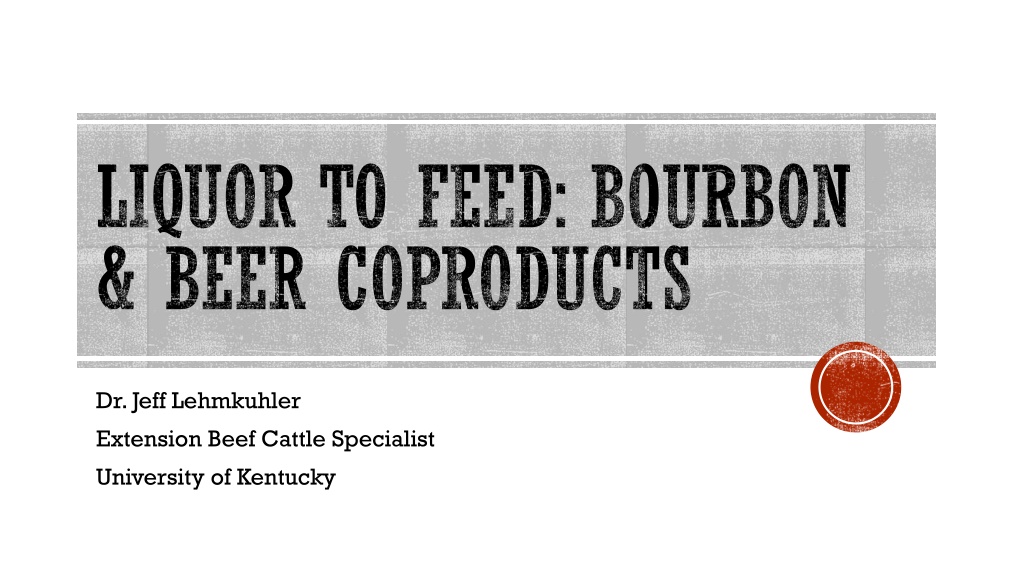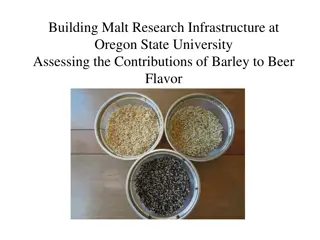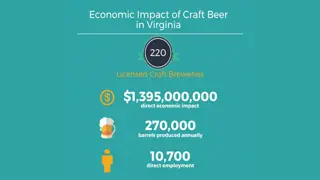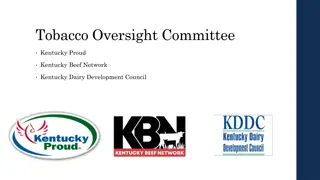Evolution of Bourbon and Beer Coproducts in Kentucky
The article explores the deep-rooted traditions of corn liquor and beer production in the Ohio River Valley, highlighting key players like Jacob Beam and George Wiedemann. It delves into the booming trend of craft distilling since 1995, elucidating the rise in bourbon production and the resulting increase in availability of coproducts like stillage and distillers grains. Analyses of various slop products and the composition variation by grain source are discussed, along with historical feeding problems associated with stillage. Recommendations for balanced ration feeding techniques are also provided.
Download Presentation

Please find below an Image/Link to download the presentation.
The content on the website is provided AS IS for your information and personal use only. It may not be sold, licensed, or shared on other websites without obtaining consent from the author. Download presentation by click this link. If you encounter any issues during the download, it is possible that the publisher has removed the file from their server.
E N D
Presentation Transcript
LIQUOR TO FEED: BOURBON & BEER COPRODUCTS Dr. Jeff Lehmkuhler Extension Beef Cattle Specialist University of Kentucky
CORN LIQUOR & BEER DEEP TRADITION IN OHIO RIVER VALLEY 1770 s Jacob Beam started distilling in Bardstown, KY Louisville Frankfort, Owensboro and other regions were distilling George Wiedemann purchased Constans Brewery in Newport, KY in 1890 as George Wiedemann Brewing Co. Largest brewery in the state at 100,000 barrels / annually in 1890 By 1967 capacity was 1,000,000 barrels / year Ceased production in 1983 in KY and by 2006 no Wiedemann beer
CRAFT DISTILLING BOOMING ~ 1995 there were 50 craft distillers, 2015 = 769 (Chris Morris http://fortune.com/2015/08/01/distilleries-craft-beer-liquor) Kentucky Bourbon production has increased 300% since 1999 Led to increased availability of stillage, condensed solubles and distillers grains
PROCESS OF DISTILLING SOURCE OF FEEDS Thin Stillage Boruff 1947 2nd Proc Feeds of Beverage Distilleries
ANALYSIS OF VARIOUS SLOP PRODUCTS Item, %DM Protein, % Fat, % Fiber, % Ca, % P, % Thin 32.5 15 5 0.25 1.25 Settled 31.9 12.8 6.4 0.21 1.06 Whole 29.6 9.9 7.4 0.25 0.62 Evaporated 30 14.4 4.4 0.13 1.13 Total Solids, % Water, % No. Samples 4.0 96 10 4.7 95.3 11 8.1 91.9 5 16 84 2 Garrigus & Good 1942 KY Ag Exp Station Report
COMPOSITION VARIES BY GRAIN SOURCE Wheat Barley Corn Thin Stillage 8 14 34 4 46 2 28 Distillers Grains 4 4 74 22 26 2 7 Thin Stillage 10 16 32 8 37 1 38 Distillers Grains 4 6 80 31 15 1 4 Thin Stillage 7 9 13 NA 19 25 NA Distillers Grains 5 10 45 NA 30 8 29 Ash EE NDF ADF CP Starch NSC Mustafa, A., Mckinnon, J., Christensen, A. (2000) Asia Australian J. Animal Sci, 13, 1609
STILLAGE = SLOP & FEEDING PROBLEMS OCCURRED 1942 Garrigus & Good state 2 common mistakes when feeding slop Failure to use other feeds to provide a balanced ration Hauling slop too far such that the cost makes it too expensive 1. 2. They recommended the following 1. lb / 100 lb body weight of forage / hay 2. 3-6 lbs of grain offered to increase dry matter intake 3. Yellow ear corn for vitamin A & bloat reducing effect of the cob 4. White corn < 3 months 5. Free-choice limestone (2-3 oz/d) 6. Not more than 3-4 gal / 100 lb live weight gave farmers best results
FEEDING SLOP https://youtu.be/U10D9TDYtfs Video had to be removed from ppt due to size
CATTLE PERFORMANCE ON SLOP Thin Stillage Water Steers grazing crested wheatgrass Fluid Intake, gal/d ADG, lb 12.7a 3.08a 7.6b 1.98b Steers fed growing diets Fluid Intake, gal/d ADG, lb Gain:Feed (linear effect) Steers fed finishing diets Fluid Intake, gal/d ADG, lb Gain:Feed (linear effect) 6.3 3.52 0.3 6.0 3.52 0.2 7.1 3.52 0.19 7.1 3.08 0.15 Mustafa, A., Mckinnon, J., Christensen, A. (2000) Asia Australian J. Animal Sci, 13, 1609
FEEDING SLOP WAS NOT WITHOUT ITS ISSUES 1878 Harper s Weekly cartoon by Thomas Nast depicting a ghoulish figure dispensing swill milk to an unknowing mother and her children. Mid-Late 1800 s Germany, France, Europe, America & others were fighting SWILL MILK Led to early food safety regulations
SLOP WAS & WAS NOT THE PROBLEM Poor nutrition of cows due to lack of understanding how to feed Diarrhea excessive protein & fat intakes, Calcium & Vitamin Deficiencies, Low Butterfat from low fiber intakes, etc Poor udder sanitation Adulterated milk water, egg yolks, chalk, sugar, etc
SLOP FEEDING TODAY Current recommendations similar to Garrigus & Good Use as energy and protein supplement Increase dietary Ca levels Feed a balanced ration = good performance
NUTRITIONAL COMPOSITION OF PRODUCTS Considerable variation can be observed Grain source (barley, wheat, sorghum, corn, etc ) Fat extracted Solubles added back
EXAMPLE OF COMPOSITION OF ENERGY ETOH PRODUCTS Nem, Mcal/cwt 100-125 100 100 100 Neg, Mcal/cwt 69-89 68 68 68 Feed CDS Wet DGS Mod DGS Dry DGS DM % 30-50 30-35 40-50 90 CP % 18-35 30-35 30-35 28-32 Ca % 0.07 0.05 0.05 0.04 P % 1.8 0.8 0.8 0.8 S % 1.6 0.7 0.7 0.7 Based on several sources including company literature, National Research Council, and United States-Canadian Tables of Feed Composition. Today fat not being extracted from bourbon derived distillers Sulphur levels generally lower = lower risk of toxicity from bourbon source
CONDENSED DISTILLERS SOLUBLES (SYRUP) Observed Increased Availability High in Fat and Protein ~ $75 / ton DM @ 30% DM Handling Issues Craigslist Ad
LICK TANKS FOR CDS Wheel-type lick tanks can be used Doran et al., 2008 ISU Beef Report Intakes were 2.7 to 8.1 lb DM or ~ 15 to 30 lbs as-fed As pasture quality / availability declined, CDS intake increased Spoilage can occur with warm temperatures
SPRAYING CDS ON WINDROW Application using modified liquid fertilizer trailer Rates were 16, 20 and 32% Observed no detrimental impact of applying CDS to windrows pre-baling J.M. Warner MS Thesis Univ Nebraska 2012
RESEARCH UPDATE FED DAILY OPEN TROUGHS Distillers Condensed Solubles for Stockers on Fescue 2.5 2 1.5 1 0.5 0 Control 0 1% Fat BW 3% Fat BW Corn:SBM 2015 Preliminary Data Dr. Eric Vanzant & Alex Altman
WET DISTILLERS GRAINS STORAGE Shelf-life varies with storage method and temperatures Excluding oxygen and preventing airborne molds lowers spoilage losses Adding 10-20% processed forage can allow handling & packing into bunkers / bags Salt can reduce spoilage, cost effectiveness??
Comparison of Coproducts Expected due to higher Fat content http://www.noble.org/ag/research/Articles/ByproductSupplements/index.html
Comparison of Coproducts Rye balage + 4 lbs of Supplement 3.5 3 2.5 2 ADG, lb 1.5 1 0.5 0 Corn/Cottonseed Distillers Corn Gluten Feed DDG/CGF Waller, 2011 TN Highland Rim Field Day
Muck Bales for temporary bunker ~ 12 X 20 for 14-15 tons wet cake
Sulfate Reduction in the Rumen High Sulfur / Sulfate Intake (Feed + Water) H2S and S2- Eructation H2S Inhalation Lung Tissue Damage Cell Damage S2- Absorption ? PEM Secondary Viral or Bacterial Infections Poor Animal Performance Adapted from Kung et al. 1998
WET BREWERS GRAINS Generally mostly barley that has been malted Husk will result in lower energy values, digestibility Moisture levels are often much higher 22% DM, 0.93 Mcal Nem/lb, 0.62 Mcal Neg/lb, 26% CP
BEEF HEIFERS WINTERED 62% Wet Brewers 11% Corn 26% Fescue Hay 1.2 6.1 66% Corn Silage 34% Wet Brewers 1.6 6.3 Corn Silage 1.1 9.5 ADG, lb Feed:Gain Crickenberger and Johnson, JAS 1982
WET BREWERS FEEDLOT Barley/Canola 21.9 2.9 7.6 Brewers 21.0 2.9 7.3 Wheat DG 22.7 2.9 7.7 DMI ADG Feed:Gain Relatively low inclusion rates resulted in similar performance to control diet Brewers similar to Wheat-based Distillers Grains when fed to constant energy Ojowi, McKinnon, Mustafa, and Christensen, Can J Anim Sci, 1997
GENERAL FEEDING RECOMMENDATIONS Adjust mineral program to high Calcium, no Phos Up to 40% of diet DM for low Sulphur product Mindful of moisture content of total ration as inclusion rates increase, especially for slop Consider handling / storage / transportation expenses

 undefined
undefined


























